 |
Scottsdale AZ (SPX) Nov 04, 2010 Alice Springs, Australia, with around 300 days of sunshine every year, is an ideal test location for solar power installations. The Desert Knowledge Australia (DKA) Solar Centre is a government-funded public showcase of solar installations, demonstrating a range of solar power technologies from many of the world's leading manufacturers. This collection of solar installations operating under the same environmental conditions since October 2008 allows meaningful comparisons of performance among various brands. Desert Knowledge Australia Solar Centre is not a research facility, but rather a public installation to demonstrate solar power, with output data available to anyone. Kyocera's interpretation of data collected during a 24-month period and downloaded from DKA shows that Kyocera solar technology delivered more kilowatt hours per installed kilowatt than any other competing crystalline solar module operating for the same 24-month period at the DKA site. Kyocera has three polycrystalline silicon solar installations at DKA: a fixed pole-mount system; a single-axis tracker that adjusts east-west orientation throughout the day; and a dual-axis tracker that adjusts the array's up-and-down tilt, allowing for variation in the sun's angle during the year as well as moving from east to west throughout the day. In addition to its interpretive visitor center, which helps educate the public about the benefits and capabilities of solar power, DKA has a world's-first interactive website providing live data feeds from the Solar Centre and information on the operational performance of the different solar technologies. This information is available for viewing by the public - anyone, anywhere, can access it. It is important to look at the Normalised Output tab to view the actual "kilowatt hours generated" per kilowatt of modules installed. This allows comparisons between the different-sized systems. Kyocera's interpretations contrast with the old belief that monocrystalline silicon solar cells, which are more expensive, may outperform polycrystalline. "We believe there is an important difference between lab test conditions and real-world results," stated Michael Ludgate, Kyocera Solar, Inc.'s Director of Business Development and Marketing. "The live data feeds from the DKA Solar Centre provide the industry with long-term, system-level data that prove the reliability and performance of solar installations in real-world applications." The dual-axis tracking system performed best among Kyocera's three installations. Since solar panels generate the most electricity when light hits their surface directly, adjusting the surface to follow the sun increases their electrical output. The dual-axis trackers respond to light sensors on the face of the array, and are powered by the sun.
Share This Article With Planet Earth
Related Links Kyocera Solar All About Solar Energy at SolarDaily.com
 National Space Society Announces The Kalam-NSS Energy Initiative
National Space Society Announces The Kalam-NSS Energy InitiativeWashington DC (SPX) Nov 03, 2010 The National Space Society will hold a press conference Thursday, November 4 at the National Press Club to reveal one of the first initiatives ever undertaken by a non-profit American organization and a former head of state. That initiative pairs India's eleventh President, Dr. A.P.J. Kalam with America's National Space Society. Its name? The Kalam-NSS Energy Initiative. The Kalam-NSS Ener ... read more |
|
| The content herein, unless otherwise known to be public domain, are Copyright 1995-2010 - SpaceDaily. AFP and UPI Wire Stories are copyright Agence France-Presse and United Press International. ESA Portal Reports are copyright European Space Agency. All NASA sourced material is public domain. Additional copyrights may apply in whole or part to other bona fide parties. Advertising does not imply endorsement,agreement or approval of any opinions, statements or information provided by SpaceDaily on any Web page published or hosted by SpaceDaily. Privacy Statement |